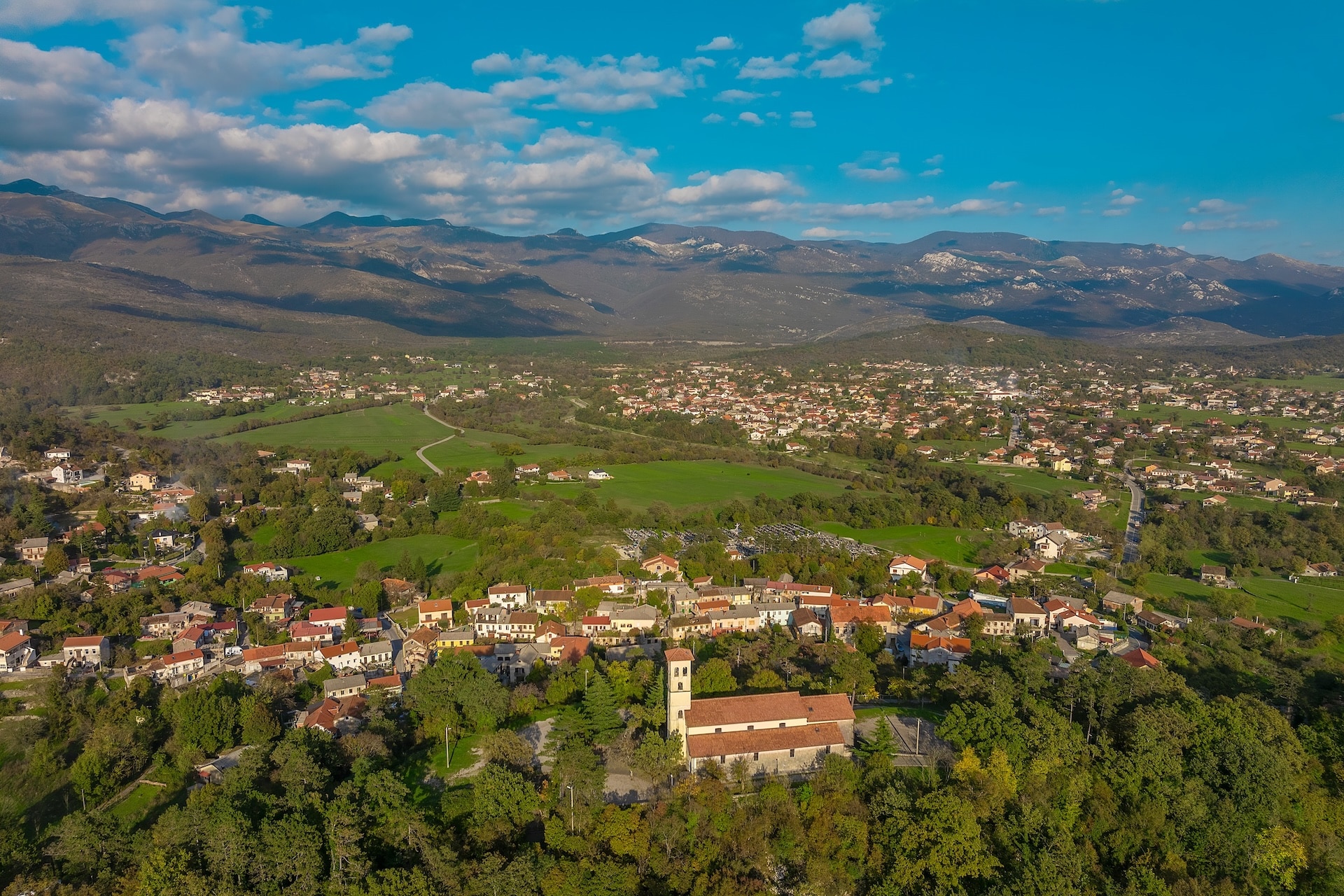MOSAIC OF
ADVENTURES
Outdoor Guide to the
Landscape of the Rijeka Ring

Rijeka and the Rijeka Ring form a unique region, surprising visitors with its natural, historical, and cultural diversity. The pleasant Mediterranean climate has shaped the once royal city of Bakar, the important industrial port of Rijeka, and the charming coastal towns of Kraljevica and Kostrena. Meanwhile, the mild continental climate has contributed to the forested landscapes of Jelenje, Klana, Kastav, Viškovo, and Čavle.
In a single day, it is possible to climb the mountain peaks of the popular Grobnik Alps and descend to one of the many beaches, making this area ideal for nature enthusiasts. The vistas of grassy slopes, the Adriatic Sea, and the hilltop towns of the Rijeka Ring intertwine with the urban buzz of Rijeka.
Once you stop here, you will discover that this relatively small yet open and welcoming region, where layered history meets dynamic traditions and vibrant everyday life, has much to offer.
RIJEKA
Rijeka is a city of rich history and dynamic present, with new horizons and a zest for life.
It complements its recently acquired appeal as a tourist hub far removed from its former image as a port and industrial city with its historic advantages – thanks to its excellent geo-transport location and connectivity by road, sea, rail, and air. Rijeka is easy to reach and serves as an ideal base for further travel.
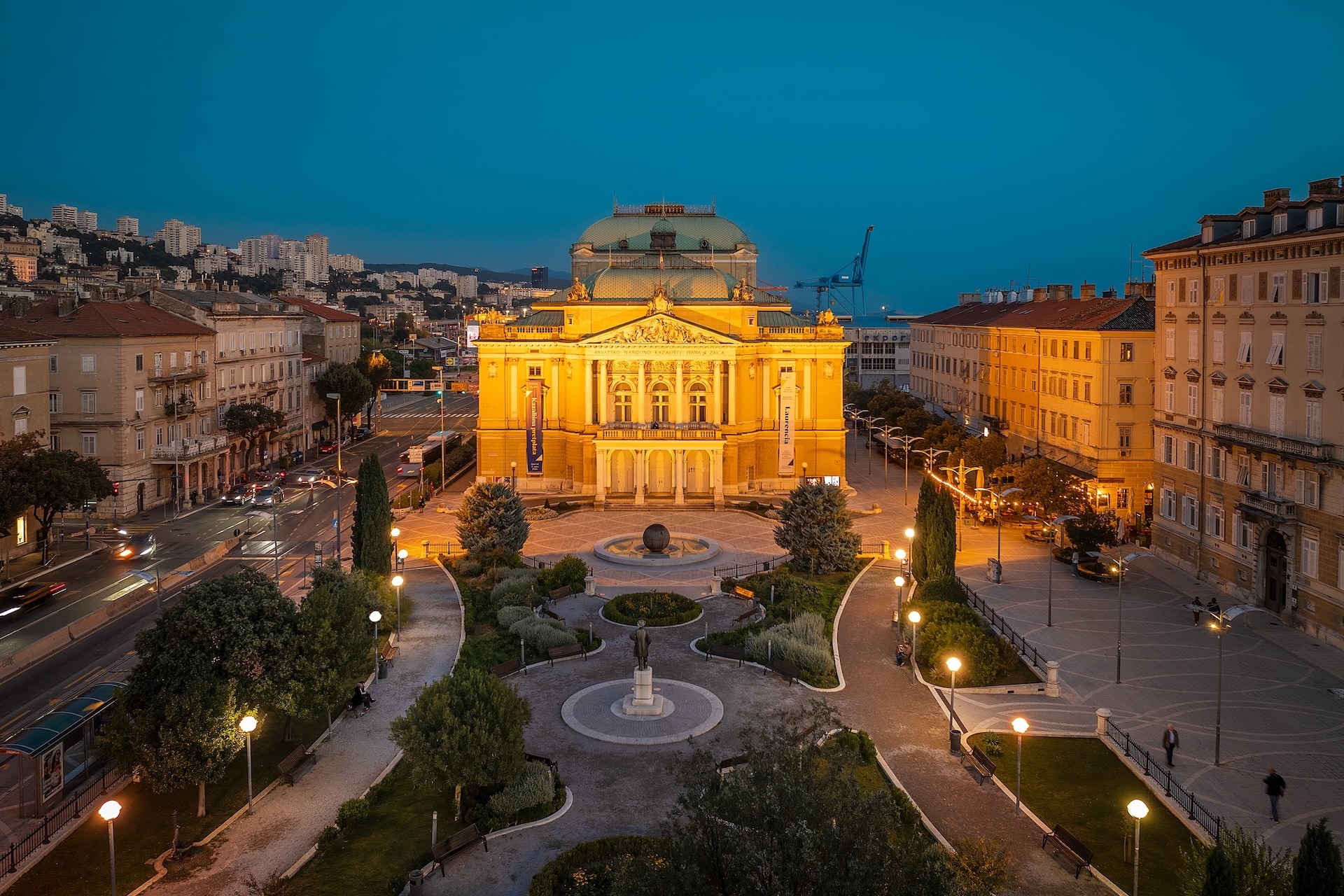
Rijeka boasts a rich past but is not trapped in it. It pulses with the dynamic rhythm of daily life, best felt in the city centre on the always lively main promenade, Korzo.
Visitors seeking a quick retreat from the city’s hustle and bustle will find solace in Theatre Park, which has won the “Blue Flower” award as the most beautiful park in Croatia. Other notable parks close to the centre include Nikola Host Park, while Trsat boasts green gems like Trsat Park and the grounds of the Shrine of Our Lady of Trsat.
Rijeka’s event calendar is packed year-round, offering a wide variety of music, drama, and visual arts activities for all generations. Rijeka’s traditional events, such as the Rijeka Carnival, Fiumanka, Rijeka Advent, WineRi, the History Film Festival, JazzTime Rijeka, and Rijeka Run, respect their long-standing traditions and attract a broad spectrum of visitors from around the world.
Rijeka also thrives along its coastline, dotted with pebbly, rocky beaches and beaches with concrete sunbathing platforms, all alongside the refreshing sea.
You can start your search for the perfect beach on the western side, from Preluk to Kantrida. In addition to sunbathing and swimming, these beaches are ideal for those who enjoy a more active holiday, both in the water and on the beach. Preluk, S zavoj, Akademija, Kostanj, Lungomare and Bivio.
Preluk Beach is famous and beloved by surfers because of its location and the blowing winds. In addition to the above beaches, this stretch of coast is also littered with tiny nameless coves and secluded beaches for those who value solitude. Some of these beaches are accessible only by sea.
A number of bigger and smaller beaches as well as coves stretch along the coast from Preluk to Bivio, connected by the promenade to plenty of nearby amenities: from bars, restaurants and sporting activities to parks and playgrounds for children shielded from the sun by lush vegetation.
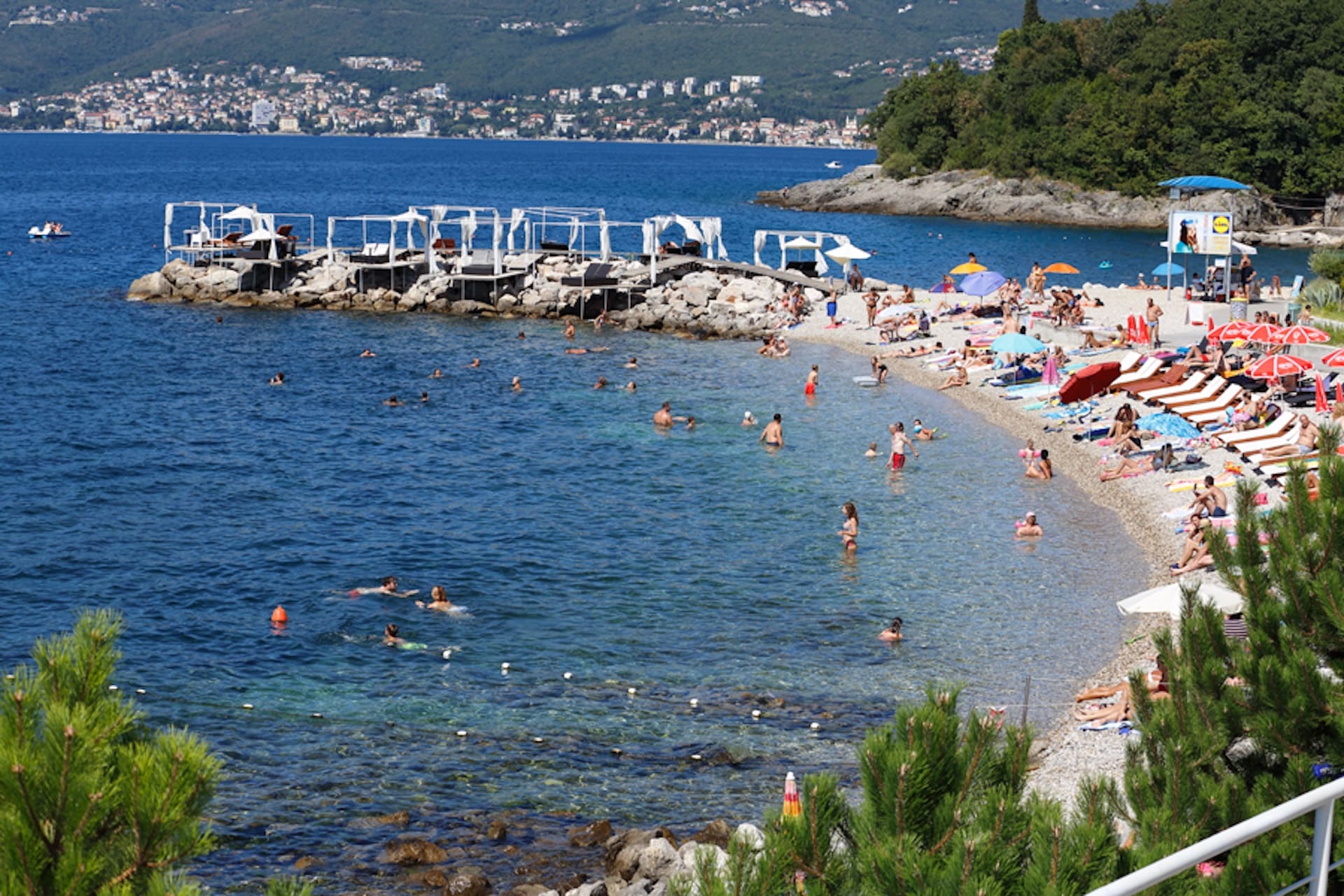
Kantrida is host to five beaches: Razbojna, Ploče, Vila Nora, Igralište and Brgudi. If you prefer swimming in fresh water, you can go for a dip and catch some rays at the Kantrida Pools, one of the most beautiful pool complexes in Croatia.
If you head east towards Pećine, you will find beaches Brajdica, Križić and Sablićevo, just a few minutes from the city centre. Further along are Vila Olga Beach, the former Hotel Park Beach, Glavanovo, Srebrena, Ružićevo, and Grčevo. These beaches, once part of the former Sušak area, were popular Mediterranean bathing destinations in the late 19th century and will appeal to visitors interested in their historical significance.
Regardless of whether you wish to relax on the beach, explore the beautiful nature or enjoy some water sports, the beaches of Rijeka provide everything you need for a unique and memorable experience.
Exploring the city on foot through planned walking routes or cycling along Rijeka’s bike trails is equally engaging.
Right in the city centre is the popular Molo Longo promenade, which doubles as the breakwater for the main harbour basin. At 1,707 metres long, it is ideal for walkers of all fitness levels. For those who enjoy coastal vistas, the western part of the city features the Kantrida-Costabella-Preluk promenade.
Visitors who can’t choose between sea and forest will love the “Green-Blue Rijeka” network of walking trails connecting Rijeka’s largest and most beautiful forests to the sea. These marked trails allow visitors, recreational enthusiasts, and athletes to create their unique green-blue routes, offering a one-of-a-kind experience.
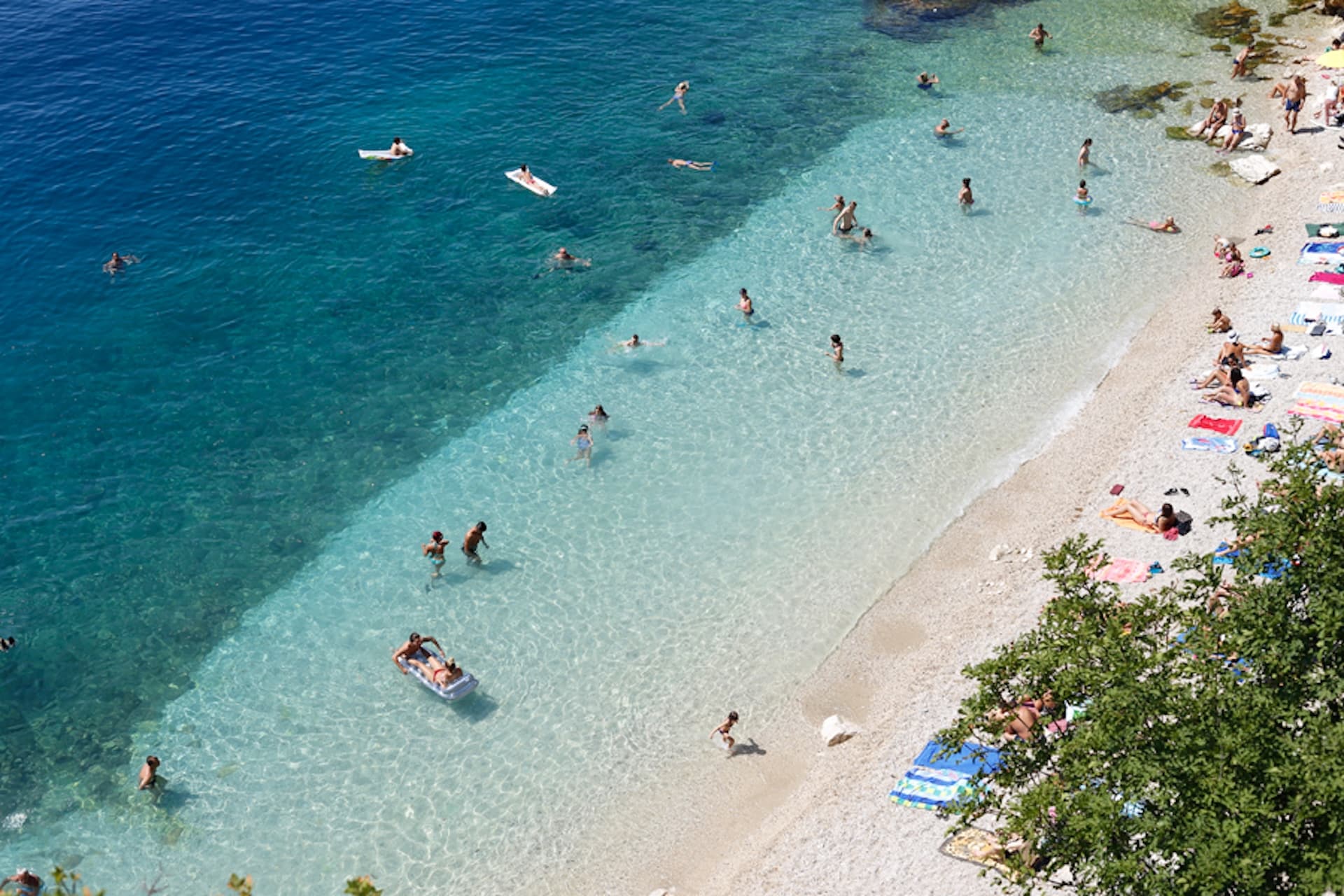
For the adventurous, the Rječina River Canyon trail is highly recommended, with marked paths leading all the way to Martin’s Village.
Honouring the city’s historical significance, Rijeka also boasts the circular thematic walk “A View of Rijeka’s Industrial Heritage”, which starts and ends at Tito Square.

If you wish, you can explore the city using electric bicycles, which can be rented at four locations where RiCikleta system terminals are situated: Jadranski Square, in front of the Youth Hall in Trsat, at the pedestrian bridge over the Rječina River (Sušak Bridge near Kont), and on the roof of the parking garage at the Kantrida Swimming Pools.
Classic cycling enthusiasts will enjoy the Rijeka Ring cycling routes that connect destinations via transversal paths, offering numerous combinations for road, mountain, or trekking bikes.
Rijeka, quite simply, has many faces – each interesting and enticing, all designed for you.
VIŠKOVO
If you’re travelling in search of living culture, Viškovo is the place to visit. Here, you’ll find an abundance of cultural treasures listed on UNESCO’s intangible cultural heritage list.
Here, you’ll find an abundance of cultural treasures listed on UNESCO’s intangible cultural heritage list. For those who enjoy active holidays, the gentle landscape invites cycling, while walking and hiking trails offer an escape from the hustle of everyday life. Gastronomic delights await in numerous restaurants, taverns, and pastry shops. Accommodation options promise peace and a pleasant rest, while Rijeka’s urban buzz, Opatija’s charm, the sea, and beautiful beaches remain within easy reach.
Viškovo’s excellent transport links to Rijeka, proximity to Opatija and the Slovenian border, natural beauty, and the benefits of a small community make it an appealing destination where modern civilisational advancements blend seamlessly with respect for tradition.

For those who love a good view, Viškovo boasts the impressive lookout point Lončeva griža, located at 506 metres above sea level in the village of Lučići, above the Saršoni settlement.
The name of the lookout is symbolic, as “griža” refers to a heap of rocks and stones.
From the summit of the griža, beneath which lies an old quarry, stunning vistas stretch out in all directions. To the north, the view spans the Grobnik Alps, the Gorski Kotar massif, and Velebit, descending over the entire Kvarner Bay with its islands and Velika Vrata Strait. It continues along the Učka mountain range, circling back to Slovenia in the distance. To the north of the ridge is a narrow valley dotted with villages, where the lively Rječina River meanders through the landscape. Looking right towards the southeast, atop a hill stands the old town of Grobnik with its castle, which in the 13th century belonged to the Frankopan counts.
The lookout point represents the highest point of the eponymous challenging hiking trail, which spans 15 kilometres.
Interpretive plaques in the Chakavian dialect, standard Croatian, and English describe the quarry work at Lončeva griža, where single stones were extracted. A smaller quarry above the village of Skvažići provided stones for local needs.
Thanks to the research of Damir Petrc, an exhibit of old quarrying and stonemasonry tools is displayed on the rock beneath the lookout point. Visitors can learn about the quarrymen and stonemasons who earned their livelihood through hard labour. The same rock also features an open-air art exhibition, showcasing works by members of the amateur art association “Braća Baštijan”, inspired by traditional Viškovo motifs.

The Plešivac Walking Trail, 8.6 kilometres long, is suitable for all ages. It offers peace, recreation, and the enjoyment of forest landscapes, with some spots providing breathtaking views of Kvarner Bay. The trail connects Marčelji with Tibljaši, and its highest peak, Plešivac (meaning “bald”), stands at 429 metres above sea level. With gentle inclines, it offers an opportunity to immerse yourself in forest scenery.
The walking trail connects with a cycling path leading to Ronjgi and the birthplace of Ivan Matetić Ronjgov, now a museum and memorial centre.
An easier yet equally attractive path is the “From Kalić to Kalić” Trail, linking the villages of Blažići and Mladenići. It passes through wooded areas, over elevations offering unexpected views, and alongside hidden waterholes known as “kalići”, a unique natural heritage of this region.
At the trail’s entry in Blažići, you’ll notice a waterhole with an impressive dry-stone border. Once an irreplaceable water source for locals and livestock, it now serves the forest’s inhabitants. Perhaps during your walk, you might spot a deer or notice a newt in the pond. A closer look at the rock will reveal the engraved year 1891. The pond’s edge was created using the art of dry-stone construction, or assembling stones ‘dry.’
This technique has earned a place on UNESCO’s list of intangible cultural heritage of humanity.
Over time, due to natural and social influences, stones from the edge fell into the pond. In collaboration with experts, the stones were retrieved, shaped, and returned to the border, preserving its characteristic appearance and halting its decline.
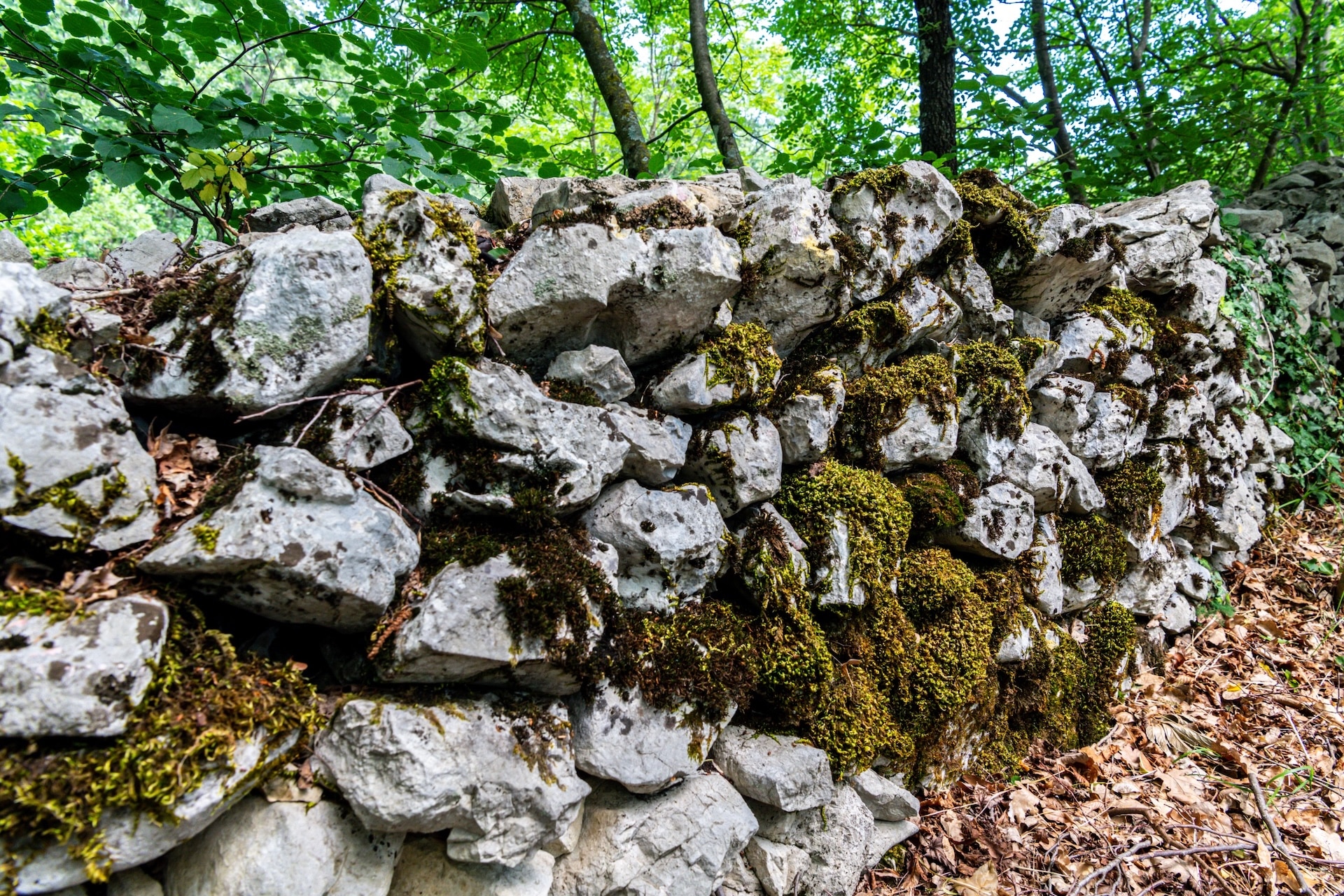
The former cart path, bordered by dry-stone walls, has for centuries steadfastly accompanied the steps of farmers, milkmaids, schoolchildren, and now modern-day seekers of tradition, peace, and relaxation.
Dry-stone walls represent a characteristic construction method in this landscape, evident on the “Path from Mića and Vela Sopela”, part of the walking and recreational offering. This path is also linked to the life story of one of Halubje and Kastavština’s most notable figures – composer, ethnomusicologist, and music educator Ivan Matetić Ronjgov.
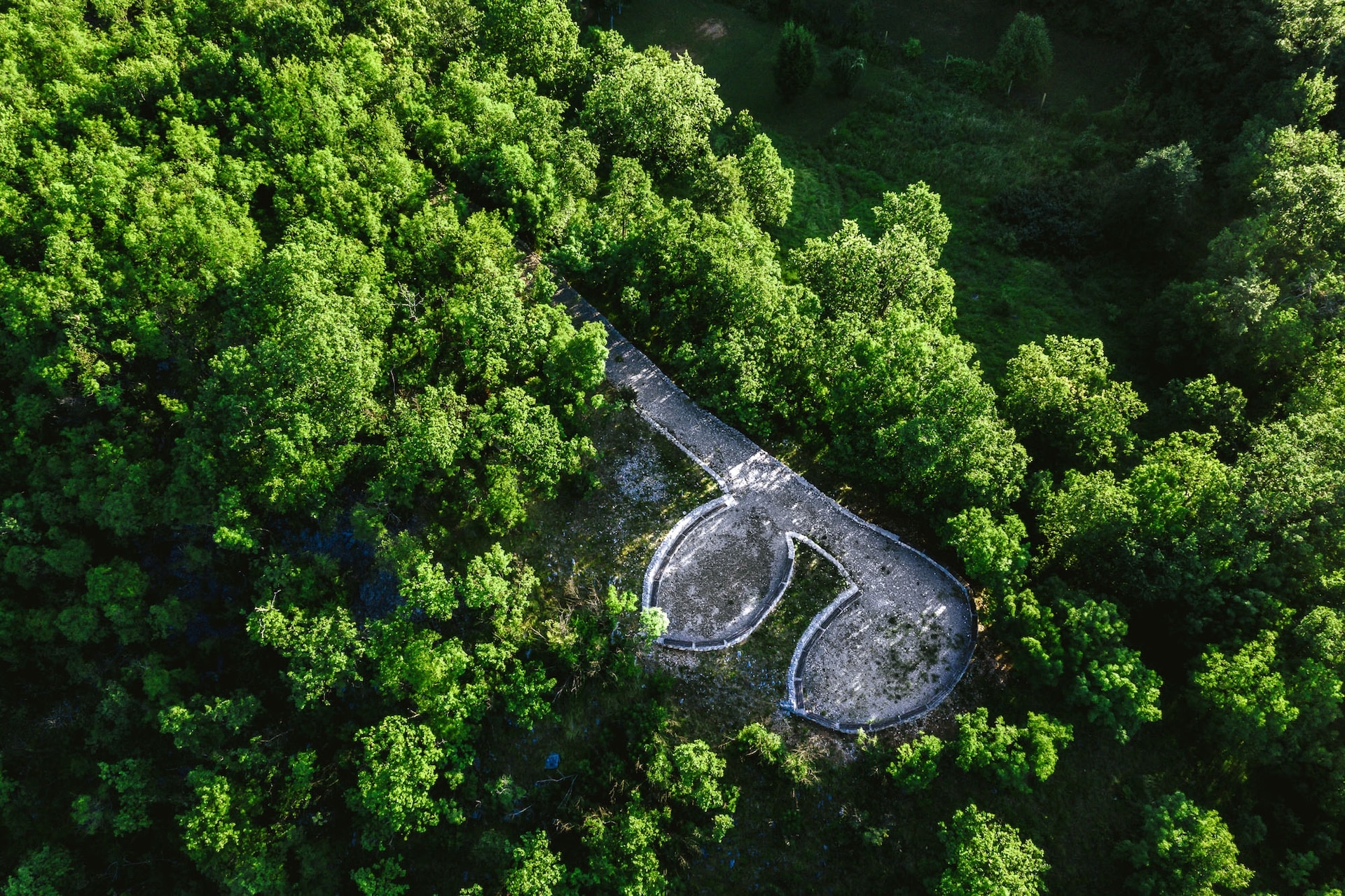
A leisurely walk leading to the lookout offers stunning views of untouched nature and the historic town of Kastav. In every season, the sparse karst terrain welcomes visitors to a wooded area predominantly covered with hornbeam, oak, and low vegetation.
If you wish to explore nearby locations, the Milohni trail is an ideal circular walking path leading to the Kapitovac waterhole, located in a deep sinkhole near the village of Milohni. A forest access path bordered by dry-stone walls takes you to the deep sinkhole, and a steep trail leads to the walled waterhole surrounded by deciduous trees.
The villages of Viškovo are surrounded by a gentle landscape inviting the discovery of traces of the past.
If you prefer to explore the area by bike, embark on an adventure along local trails using HALUbike, a public bike rental and sharing service available at two bike-sharing stations.
In the centre of Viškovo, at the Milihovo parking lot, you’ll find a station with six mechanical and six electric bicycles. Another station, located in Ronjgi near the network of walking and cycling trails and the “Ivan Matetić Ronjgov” establishment, offers four mechanical and four electric bicycles. Five marked cycling routes (Viškovo, Kastav, Studena, Rječina Spring, and Breza) take you through Viškovo’s story, intertwining modernity with history and deeply immersed in natural beauty. For outdoor adventure seekers, these trails offer a perfect opportunity to discover Viškovo’s hidden corners.
Wherever you choose to go, let the paths guide you to peaceful spots and enchanting views.
Admire the builders of the circular figures that embrace sinkholes and ponds, cycle past century-old dry-stone walls, follow the relief shapes and former boundaries, and enjoy the winding tales of bygone centuries.
For cyclists with their own equipment, the Rijeka Ring Cycling Transversal, spanning 100 kilometres, offers various route combinations for exploration.

KLANA
A harmony of nature and history, the town of Klana, located 18 kilometres from Rijeka, is writing an increasingly vibrant tourism story.
For recreational walkers, hikers, and cyclists, the area offers well-maintained and marked trails and paths, linking Klana with significant historical landmarks and making it an interesting and vital link in the Rijeka Ring.
This is a land of stunning natural beauty and valuable historical monuments, allowing cyclists and walkers to explore unique local sites while combining a love for nature with an appreciation of history. One such site is the archaeological location of Gradina, situated just above the town of Klana.
Visitors will also be intrigued by the fortifications and walls of the Liburnian Limes, built in the 3rd and 4th centuries, as well as a historical collection of old weapons, an ethnographic collection, and more.
This region is also home to numerous small, romantic churches, such as the Chapel of Our Lady of Lourdes, built at the site of the Marian apparition. Each year, on 15 August, a procession takes place here, followed by a Mass. In Klana, history and the present day, spirituality and daily life blend into a harmonious whole.

For those who prefer exploring landscapes on foot, a walking trail connects Klana with Kastav and leads to the Mačkov Vrh rest area (504 m), offering panoramic views of the Kastav area.
Passionate hikers will enjoy choosing from 11 marked trails, some of which include a visit to the Rebar Mountain Hut. This charming hut, originally built as a road worker’s shelter in the style of the Istrian kažun, now features a landscaped area and stands as one of the most remarkable spots in the Stara Rebar forest.
The area’s appeal is enhanced by wheel ruts, remnants of old wagon trails on the oldest Klana-Paka road near the hut, evoking images of the lives of previous generations.
Klana is also ideal for cyclists, with three cycling routes of varying difficulty – easy, medium, and moderately challenging. These local routes traverse enchanting, wooded landscapes and neighbouring villages. For those seeking more adventure, the Rijeka Ring bike route is highly recommended.

Klana is uniquely known for hunting tourism, a tradition that dates back centuries. Today, within the Municipality of Klana, a hunting association operates with over 100 members, managing the communal open
hunting ground “Smrekova Draga”, located in the magnificent tranquillity and greenery of centuries-old beech and fir forests. The area is home to diverse wildlife, including deer, roe deer, wild boar, chamois, bear, wolf, lynx, fox, wild cat, hare, marten, badger, dormouse, and hazel grouse. Witnessing a stag’s roar on the slopes of Obruč, Osoje, or Nebesa as the sun sets and ships dot the Kvarner Bay in the distance, illuminated by the thousands of lights along the Opatija Riviera, leaves a lasting impression on hunters and nature lovers alike.
Hunters are provided with comfortable accommodation at the “Suho” Hunting Lodge, and eight enclosed hunting stands are equipped with all the comforts needed for a successful hunt.
Visitors can also engage in commercial hunting for woodcock and quail.
KASTAV
Kastav, along with the Kastav region, is synonymous with rich history, geographical diversity, fascinating architecture, and a unique tourist offering.
Perched “above the sea, like a hawk”, as the poet says, Kastav resembles other coastal towns yet stands apart with its soul nestled in a stone haven, spacious enough for all who are ready to experience it in its entirety.

Kastav gives to everyone and receives something in return. Anyone who hears the echo of their footsteps on its ancient, polished stone, once trodden by so many before them, will always return.
Even in the busiest of times, as something is always happening in the town, Kastav invites a quiet dialogue between past and present, where the personal bond between a person and the town grows into something far greater and more meaningful.
There are few towns in the world where you can walk directly into a forest from the centre. Kastav is one of them. The centuries-old Loza and Lužina forests are green jewels of the Kastav region, where many come to recharge.
These forests blend so seamlessly with the town that it’s hard to distinguish where the urban area ends and the forest begins.
Thanks to the proximity of Loza and Lužina, Kastav is a favourite destination for outdoor enthusiasts. Here, you’ll encounter runners, cyclists, trail lovers, and walkers.
Snail, Hare, and Deer are the names of three designated walking trails that lead you through nearly every corner of Loza and Lužina. Their difficulty and length are tailored to suit all ages and abilities, accommodating both recreational visitors and athletes.
Every season is perfect for activities on these trails, whether walking, cycling, hiking, or horseback riding.
While enjoying outdoor activities in the fresh air and beautiful nature, exploring Kastav’s forest paths, don’t forget to take in the unique views from Kastav’s peaks that stretch across the surrounding area. One we’ll reveal to you is the abandoned village of Cari, a former border post between Yugoslavia and Italy. You’ll have to discover the others on your own.
In addition to the three marked trails, Kastav’s surroundings are home to many other forest paths and tracks.
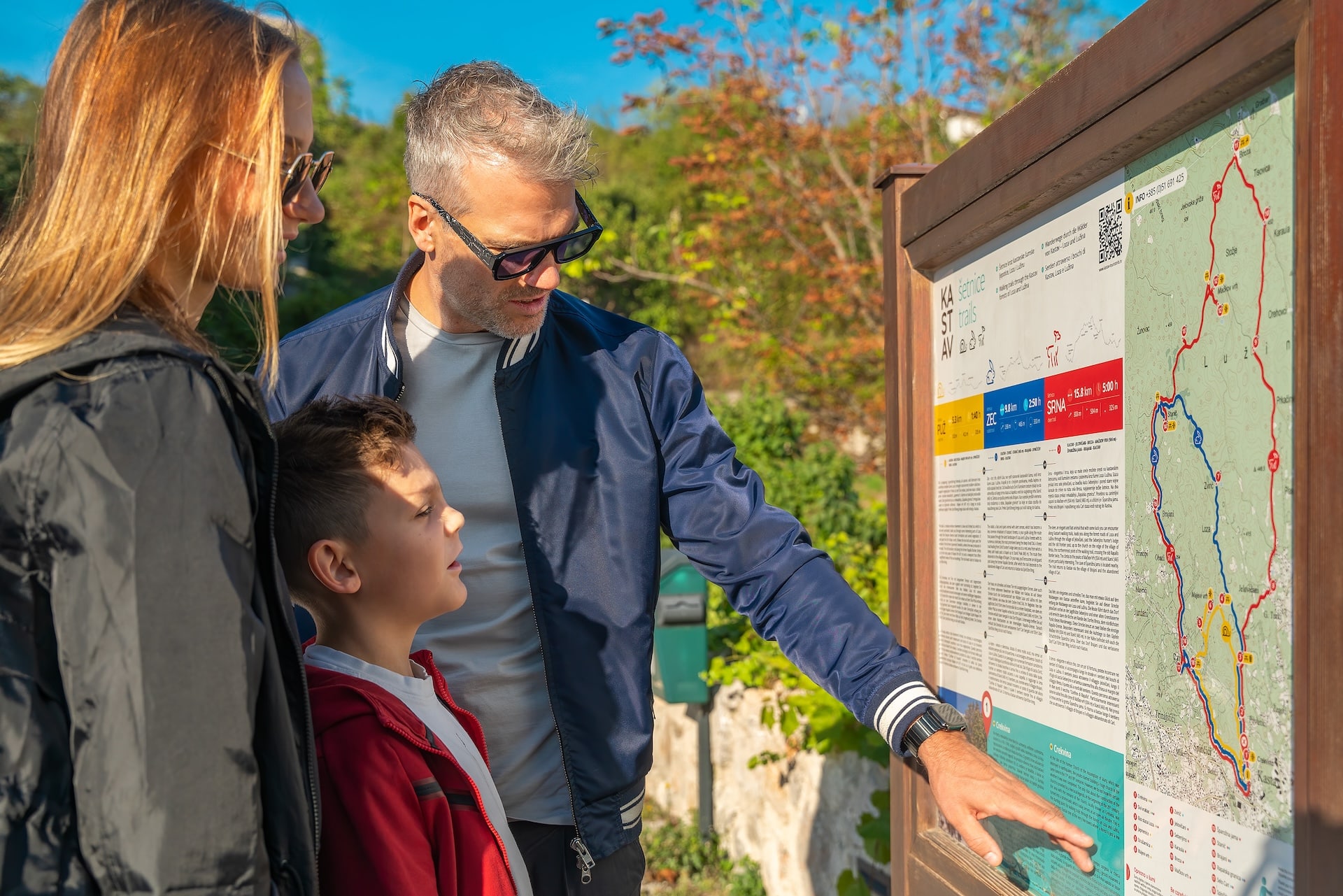
Three trails stand out for their varying levels of difficulty:
The Kastav – Eco-Trail – Majevi Vrh – Kastav is an easy walk starting at Fortica, continuing through the beautiful Loza forest, and offering the option to ascend Majevi Vrh (411 m). The Kastav – Zvirić – Stanić – Brajani – Kastav trail, slightly longer, descends into nearby villages and offers views of the remains of Cari, an excellent example of traditional rural architecture.
For those who prefer longer trails, the Kastav – Jelovičani – Breza – Mačkov Vrh – Šparožna Jama – Stanić – Brajani – Kastav trail is ideal. It climbs to Kastav’s highest peak, Mačkov Vrh (504 m), which provides stunning views of Kastav’s hinterland, Učka, and Gorski Kotar, and to the south, the Kvarner Bay.
Kastav’s forest paths are equally enjoyable for horseback riding and cycling enthusiasts.
At the entrance to Loza and Lužina, electric mountain bikes are available for rent, and a few hundred metres further lies the Grey Sparrow Ranch, offering trail riding, sports-recreational riding, and independent riding for beginners and advanced riders. This provides an opportunity to explore the natural beauty of Kastav from the saddle.
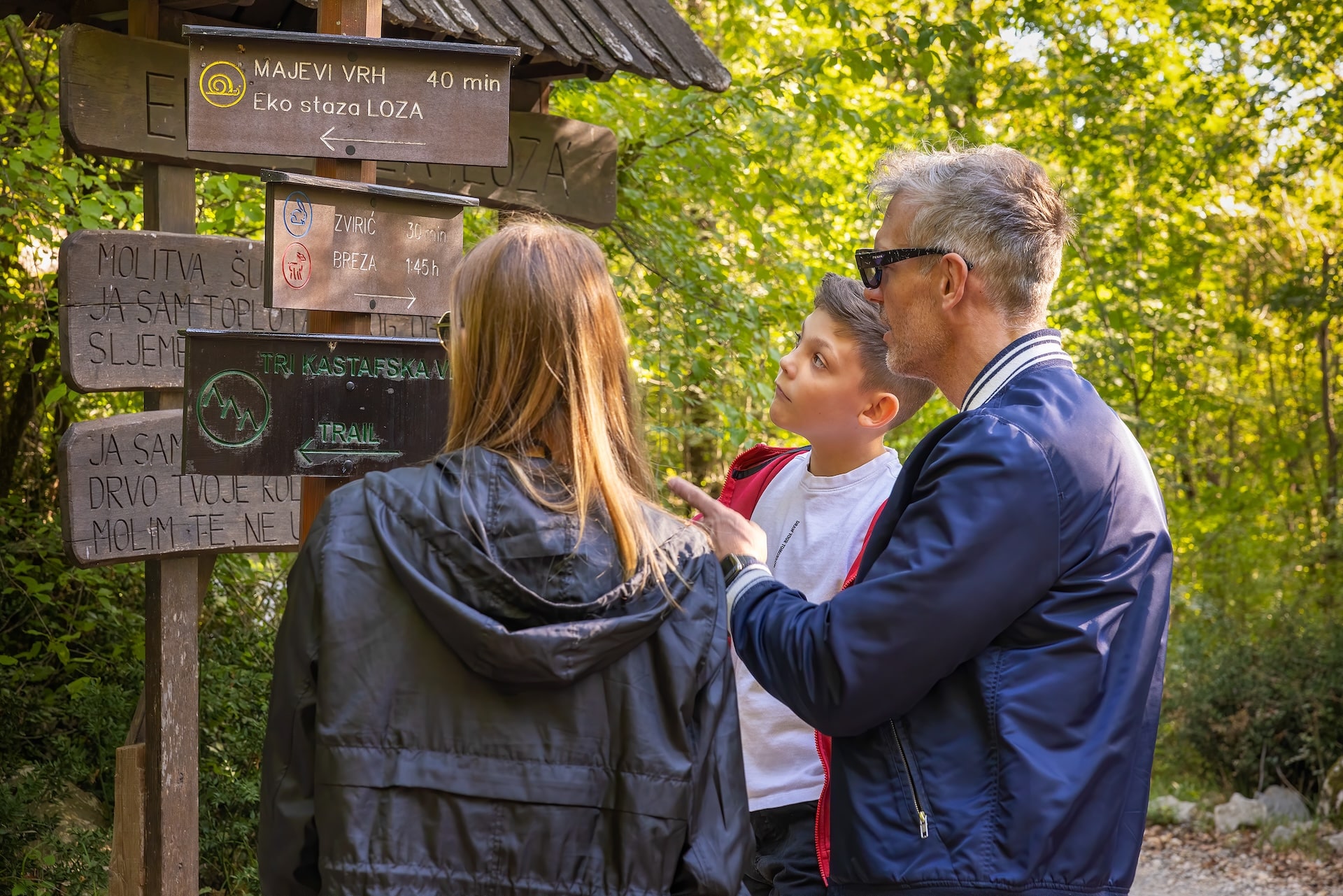
KOSTRENA
Kostrena is an ancient coastal town located near the city of Rijeka, framed by Martinšćica Bay and Bakar Bay.
The Kostrena Peninsula stretches approximately 10 kilometres and gently slopes toward the shoreline. Along its entire length, you’ll find beautiful beaches visited by thousands of happy bathers during the summer.
The most well-known and frequented beaches include those in Žurkovo Bay, Smokvinovo, Svežanj, Spužvina, Podražica, Nova Voda, and Perilo. The area is characterised by its karst terrain with fragrant Mediterranean vegetation, the famous Kostrena stone walls, and a mild climate, occasionally yielding to strong gusts of the bora wind.
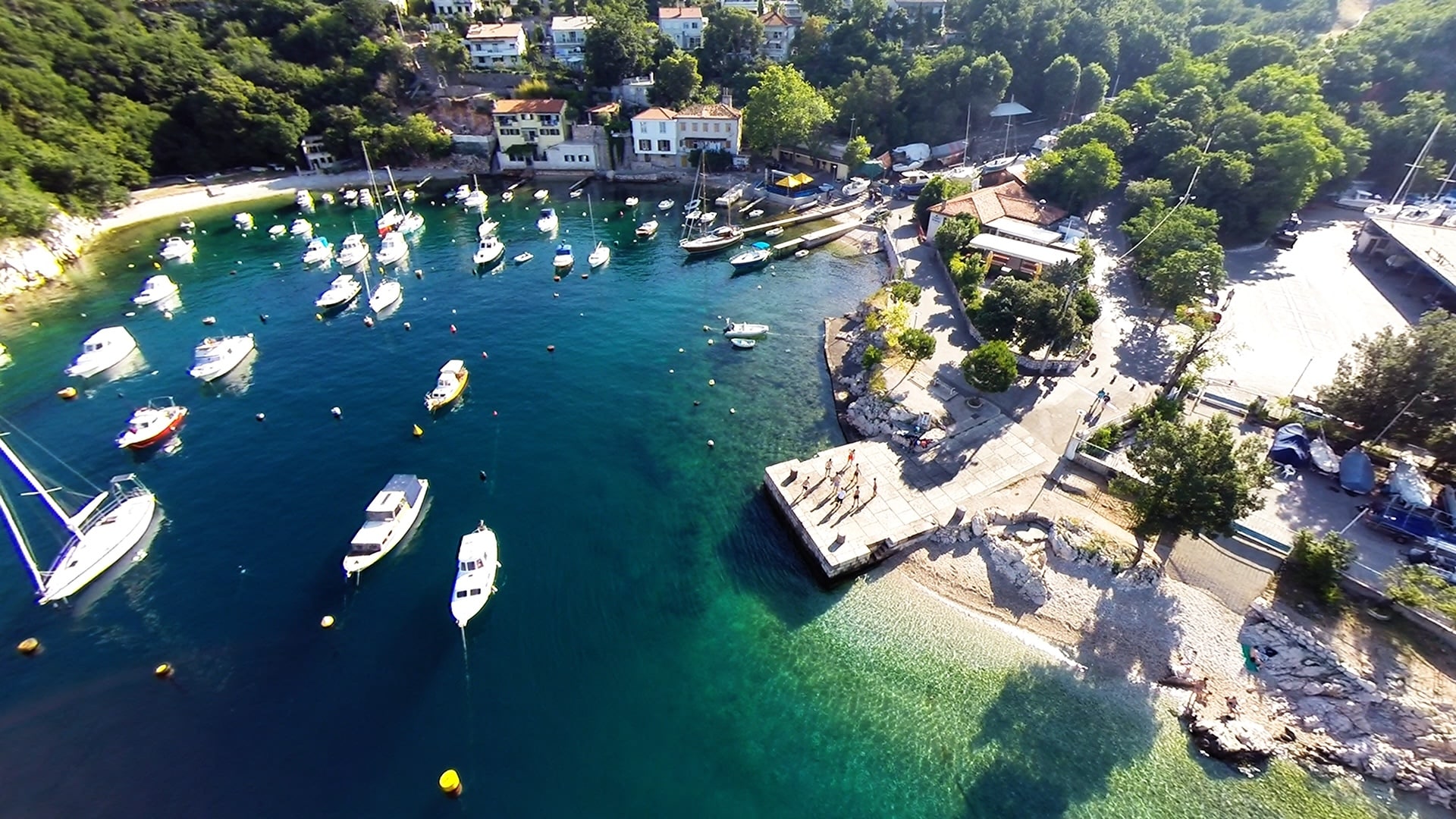
Kostrena’s residents live in about twenty settlements, many of which were named after families. Today, the most populated areas include Vrh Martinšćica, Glavani, Sv. Lucija, Rožmanići, and Paveki.
The coastline of Kostrena has always attracted numerous walkers, swimmers, and recreation enthusiasts. Its coastal promenade, where lush sub-Mediterranean and Mediterranean vegetation meets the rugged karst shoreline with steep cliffs, caves, semi-caves, and pebbled beaches, is one of the most beautiful along the Adriatic.
While Kostrena’s coastline is not heavily indented, its underwater terrain is highly diverse.
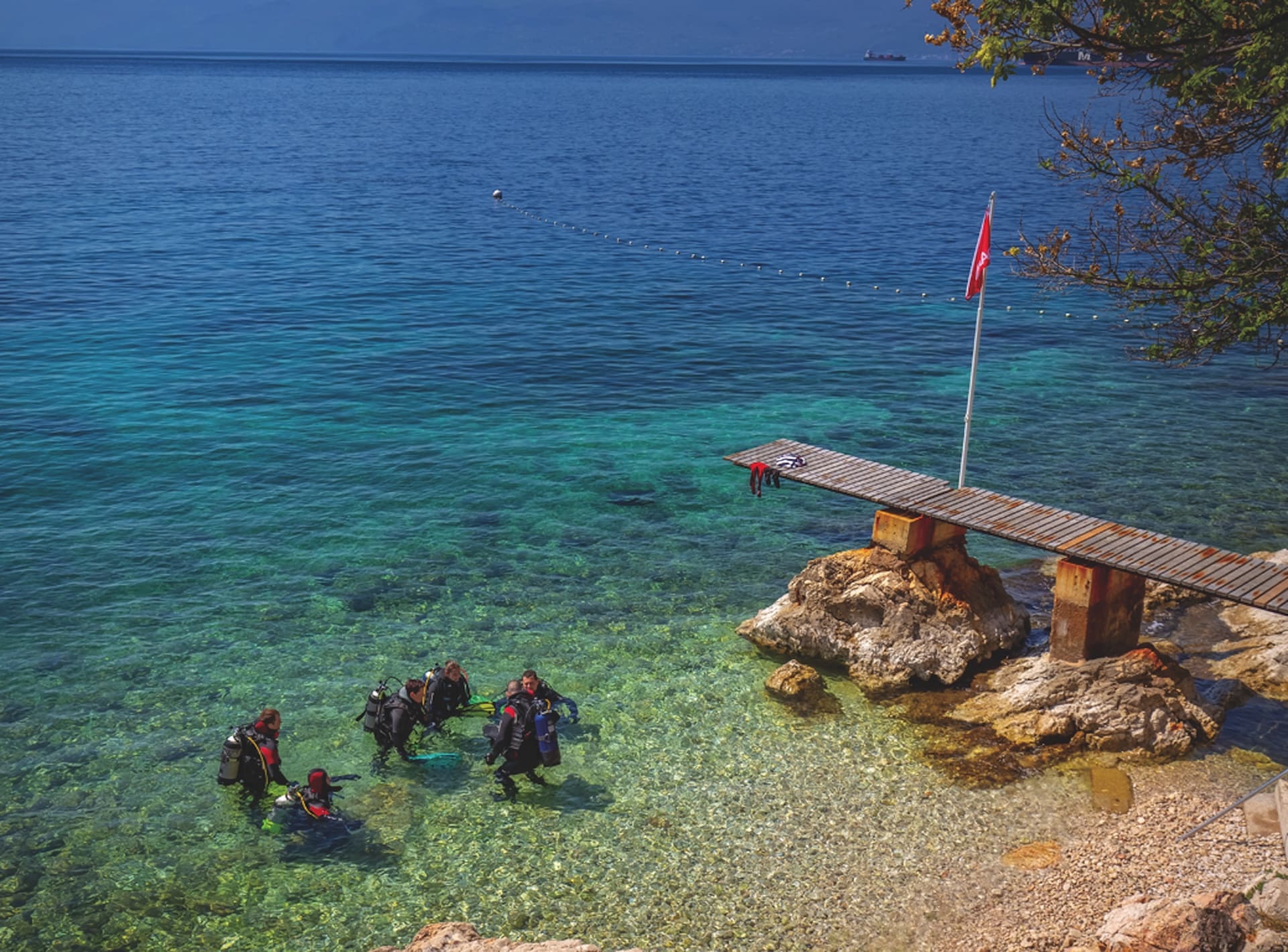
Kostrena is ideal for lovers of marine activities. Diving enthusiasts can explore the crystal-clear underwater world of Kvarner under the expert guidance of instructors from the Kostrena Diving Club.
For those who prefer to remain above the surface, the Galeb Sailing Club awaits.b.

KRALJEVICA
Kraljevica is a historic coastal town situated at the entrance to Bakar Bay, about 20 kilometres south of Rijeka.
With its rugged coastline, lush greenery, and numerous beaches, it is renowned for its scenic promenade. Two medieval castles with adjoining churches, heritage from Croatia’s noble Zrinski and Frankopan families, host a variety of cultural and entertainment events during the summer. Together with the surrounding area, Kraljevica is a popular destination for relaxation, sailing, diving, and, of course, enjoying cultural offerings.
Thanks to its geographic location, natural beauty, and healthy climate, Kraljevica became one of the first centres of health tourism at the end of the 19th century, marking the beginning of its tourism development.
Notably, the beneficial effects of the climate, particularly the bora wind, were highlighted in descriptions from the early 20th century, referencing sea, air, sun, and sand baths.

to take in the atmosphere of this region. From the sea, through the old towns in the hinterland of Kraljevica, all the way to the wooded areas, it combines many things in one: recreation, the beauty of nature, a tour of cultural monuments and a journey through tradition and many gastronomic experiences.
Whether you’re a fan of walking, cycling, or hiking, Kraljevica offers additional amenities for every type of activity. Each trail and path tells a story steeped in the respect for local tradition and cultural heritage. You can choose to follow the pedestrian path “Stazama naših nona” along the coast or “Krajolikom našim”, which partly traverses forest trails. Both routes are easy and suitable for all ages.

History enthusiasts can opt for the route “Putovima Frankopana do Hreljinske gradine” on foot or take the cycling tour “Tragovima Frankopana”. Both options include visits to the Nova Kraljevica Castle and the Old Town of Hreljin.
Hikers will likely want to conquer the “Planinarskim putovima Frankopana” trail, which encompasses 20 Frankopan castles and sacral buildings along with 21 mountain peaks in the Primorje-Gorski Kotar County. Two of these points are located in Kraljevica. For visiting all 20 castles and sacral sites, a bronze badge is awarded, while the basic recognition of this hiking tour is the silver badge, granted to those who prove they have visited all 21 mountain peaks (mandatory checkpoints). The gold badge is awarded to those who complete all 41 checkpoints.
For those who prefer guided tours, we recommend embarking on the educational adventure “Paths of the Hunters”. This journey, which explores the beauty and uncovers the secrets of the Kraljevica area, will leave everyone breathless.
Families with children, as well as others interested in animal and plant life, can enjoy the farm of the indigenous Primorje-Dinaric donkeys. This unique site will make your visit to Kraljevica even more special and complete.
Given its location, Kraljevica also offers numerous possibilities for sea adventures, including fishing with Tira Fishing. A team of enthusiasts specialising in big game fishing will take you on a unique adventure, giving you the opportunity to experience the thrill of catching big fish or seasonal fishing.
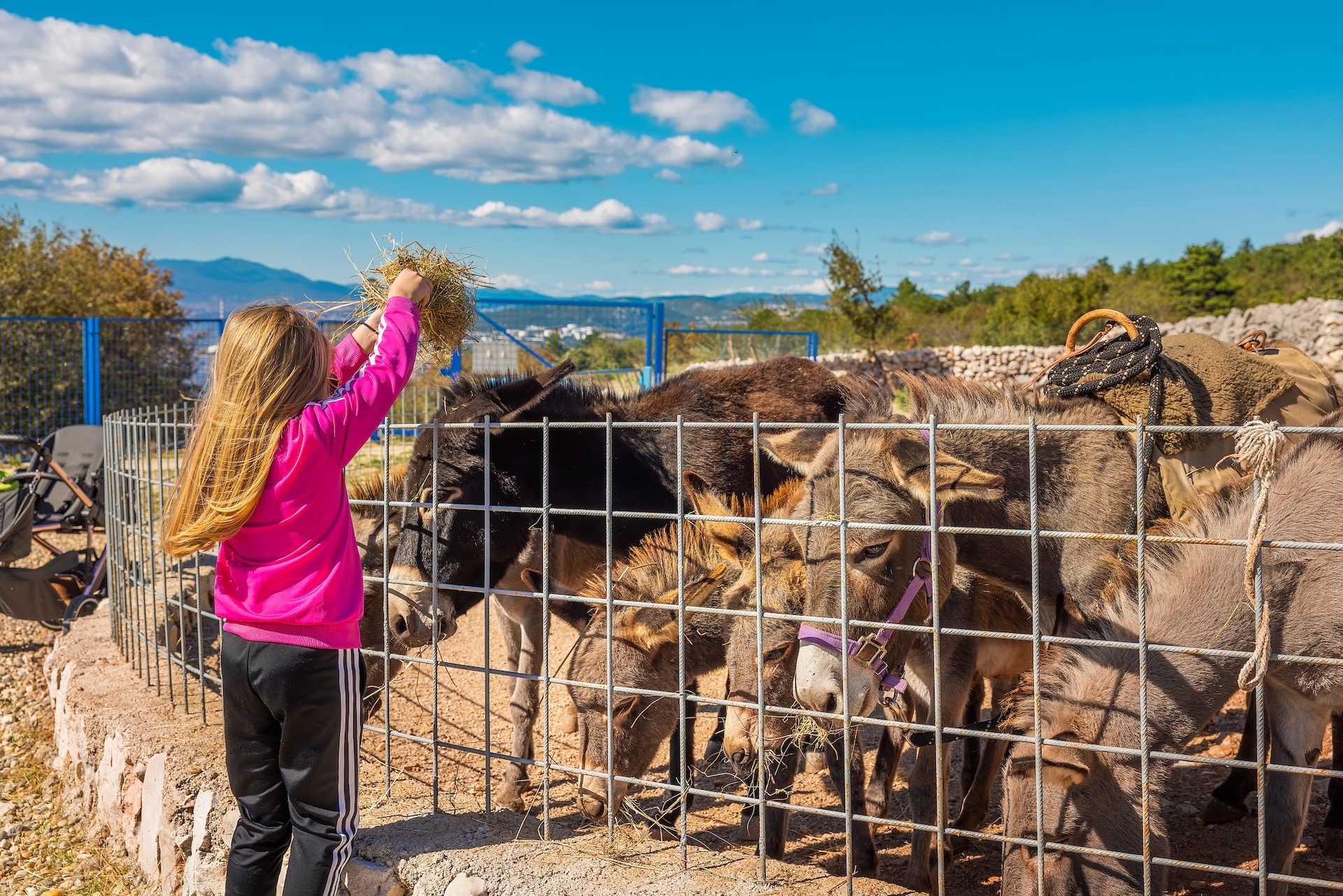

For those seeking more privacy, boat rentals are available in Grabrova Bay within the Uvala Scott Complex. Relax on a boat and enjoy the beauty of hidden coves, islands, and islets.
For an adrenaline rush, the Kartodrom Bura awaits, renowned for its high-quality vehicles and tracks, promising incomparable fun for visitors of all ages.

BAKAR
Bakar is an ancient port and one of the oldest towns on the Adriatic.
The Mediterranean Sea reaches its furthest inland point here in the Bakar Bay, which boasts depths of up to 44 metres.
Nestled within this bay, Bakar rises proudly on a hillside, resembling a stone amphitheatre. Present on the stage of history for 5,000 years, its old town core was registered as a cultural monument in 1968. Every step through its streets and surroundings unveils a new, thrilling story and unexpected contrasts.

The City of Bakar spans 126 km² and encompasses diverse natural features. Bakar and its eight surrounding settlements – Hreljin, Krasica, Kukuljanovo, Plosna, Ponikve, Praputnjak, Škrljevo, and Zlobin – offer an array of attractions. Highlights include the vineyard terraces enclosed by dry-stone walls, known as the Bakarske Prezidi-Takala, the karst lake in Ponikve that appears and disappears, the medieval ruins of Hreljin perched 321 metres above sea level, and the peak of Risnjak. Together, they create a region ideal for visitors seeking both cultural and active tourism.
Bakar is often referred to as a “small gem of grand stories”. The fusion of blue sea and green mountains makes it an easily accessible destination for those who enjoy combining cultural exploration with outdoor activities.
The Bakar area features a variety of thematic walking trails that blend leisure and education. While enjoying the captivating scenery, interpretive boards and signs along the trails provide fascinating insights into the region’s cultural and natural heritage.
In Hreljin, don’t miss the “Path of the Fortress” – a 1.6 km thematic trail leading to the medieval Hreljin Fortress. The path includes a gamified Frankopan adventure.
In Ponikve, you’ll find the intriguing circular trail “Now You See It, Now You Don’t”, an 8.5 km loop around a disappearing lake. Equipped with interpretive boards, the trail introduces visitors to the area’s rich natural heritage. Nearby are the remains of an ancient Illyrian hillfort.

From the Bakarske Prezidi, a short thematic trail leads to the nearby Črni Vrh, offering a journey into the natural heritage of the area. The trail culminates in an “ascent into prehistory”, as it leads to another Illyrian fortress. Given that it is a climb, the view awaiting you at the top is not one to dismiss. Quite the opposite.
You can also find a themed walking trail in the town of Bakar itself. Following the course of the Bakar Stream, this promenade reveals a rarely seen perspective “behind the scenes” of Bakar’s Upper Town and Kaštel. The trail is not long, meandering through pleasant greenery, and it will take you straight to the top of Bakar’s Old Town, in close proximity to the Kaštel.

The Bakar area also offers various cycling routes. Some are easy and recreational, while others are intended for those in slightly better physical condition. However, none of them will leave you indifferent.
Whether you follow the “Frankopan Trails” or explore the Viewpoints of Bakar’s Hinterland, you’re sure to enjoy the diverse experiences this region offers.
The cycling traverse of the Rijeka Ring enters the Bakar area at Škrljevo, continuing through Krasica to Hreljin and into the mountainous section of the route. Spanning nearly 80 km, this unique cycling experience connects destinations from Kastav on the north to the edge of Vinodol on the south. Given its length, it’s advisable to tackle the route in stages, with breaks, relaxation, and overnight stays. Let Bakar be the highlight of one of your stops!
Situated at the meeting point of sea and mountains, the Bakar area is ideal for short and long hiking trips. Whether you’re a beginner, a recreational hiker, or a professional, you’ll find a trail that suits you. All trails offer unforgettable views of Kvarner Bay, the coastal mountains, and Gorski Kotar.
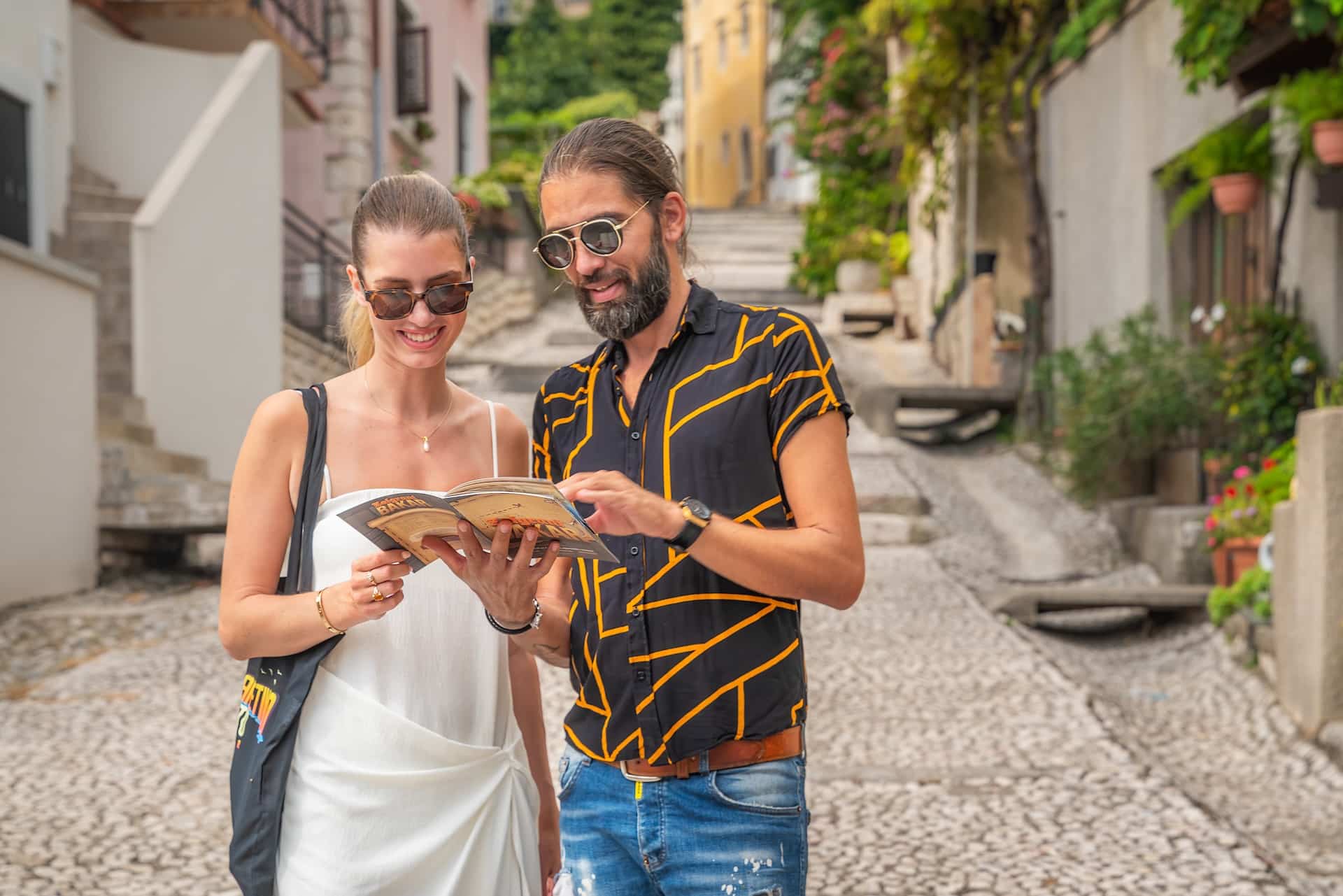
Bakar’s hiking trails include Tuhobić from Zlobin, the Panoramic Path Trebestin, and Herman’s Path. A standout experience is the ascent to Veliki Risnjak, the 1,528-metre-high crown of the Risnjak National Park and the tallest point in the Bakar area. Bakrani’s ascent to Risnjak begins in Gornje Jelenje, where a 7 km relatively easy trail leads to the Vilje locality. If you wish to shorten the climb, you can leave your car directly at Vilje. The Risnjak mountain is the heart of Gorski Kotar, home to numerous flora and fauna, including iconic predators like the brown bear, wolf, and lynx. The view from its peak – the second-highest in Gorski Kotar – is extraordinary, stretching from Kvarner Bay to the Julian Alps.
In addition to exploring its treetops, Bakar, as a historic maritime hub, also offers underwater diving adventures. You can discover Bakar Bay and the Kvarner archipelago by boat through taxi boat or rent-a-boat services.
ČAVLE
Just eight kilometres from Rijeka, en route to Zagreb, lies the Municipality of Čavle.
A view worth admiring awaits as you ascend the historic Lujzijana road to the plateau of Buzdohanj, where you can gaze upon the Grobnik Alps. Sometimes grey, sometimes green or blue, they are perhaps most beloved by Rijeka’s residents and visitors when blanketed in snowy white. This picturesque scene connects to the slopes of Platak, a regional sports, recreation, and tourist centre that uniquely offers skiing with a view of the sea.
Platak is an endless source of hiking trails, walking paths, cycling routes, and hidden tracks. To fully experience it, more than a day’s visit is ideal.
Fortunately, the area offers two mountain lodges – Veliki planinarski dom “Platak” and Planinarski dom “Promocija Platak” – providing comfortable accommodation and excellent local gastronomic specialties. Open year-round, these lodges are perfect for refreshment after any physical activity.

Nearby is the Grobnik Automotodrom, a hub for motorcyclists from across Europe, and a small airfield, making Grobnik a meeting point for fans of speed, competition, and adrenaline.
Since its opening in 1978, the Automotodrom has attracted 80,000 visitors annually, including drivers, competitors, and spectators, for both daily training and international events. Professional teams from all over Europe come to the track, and passionate drivers can explore it during GROBNIK OPEN DAYS.
Located directly off the Zagreb–Rijeka highway (A6) after the toll booths, the track is easy to find. Follow the signs for AUTOMOTODROM GROBNIK, and the roar of powerful engines and tyres will lead you to this gem of Grobnik.
Grobnik also boasts labyrinths! Five labyrinths at the entrance to the Automotodrom enchant every visitor. These sources of energy and inspiration take you on a spiritual journey without covering vast distances.
Due to its unique relief, geological structure, and varied vegetation, the area is home to Mediterranean flora as well as species typical of higher altitudes, such as linden and elder.

This region is steeped in history. Walking through Grobnik Field, you’ll encounter remnants of the Roman Limes. Many armies have passed through this land, and numerous battles have been fought here, the most famous being the one against the Tatars in 1242.
Legend has it that the morčići – distinctive Rijeka jewellery depicting a black figure wearing a turban – were created here in the 16th century as a symbol of the fight against the Turks. Perhaps a morčić earring, pendant, or bracelet will become your souvenir from the Rijeka region. Above Grobnik Field lies Grad Grobnik (Grobnik Town), a stone fortress that was a signatory to the Vinodol Code in 1288, one of the oldest legal documents written in Croatian.
The rich history and early Christianity of the area are also evident in the Church of St Philip and James, which has stood for over 900 years. Grad Grobnik is home to the only museum of contemporary art in the Rijeka region.
From the Grad Grobnik viewpoint, you can enjoy a stunning panorama. For an even more thrilling perspective, explore the Grobnik area from above – parachuting, hang gliding, or flying in the cockpit at Grobnik Airfield.


Nature lovers will delight in local walking paths that also tell historical tales, such as the Milkmaid’s path or the reflective Cernik Way of the Cross.
The Milkmaid’s path was once a shortcut to Rijeka, used by workers and students, but it’s best remembered for the footprints of milkmaids who traversed it daily, carrying milk to the city.
Milkmaid’s path was once a shortcut for walking to and from the city of Rijeka. There were no buses, and road traffic, which is unimaginable today, was very rare.
This path was used by everyone working in the city, children attending grammar school, but the most lasting marks were left by the footsteps of the milkmaids who walked this path every day, twice a day.
Today, it is a picturesque walk restored by the residents of Hrastenica, ending at a chapel with breathtaking views of Rijeka and the islands beyond. Along the path, you’ll find fragrant wild herbs like sage and heather, turning a leisurely walk or bike ride into an aromatherapy experience.
Starting in Cernik, the Way of the Cross trail leads to the top of Cerničko Brdo. The maintained trail passing by the Stations of the Cross offers an ideal opportunity for reflection and, with a leisurely walk, leads to the summit.

There, you can rest beneath three crosses and enjoy the peace and quiet while taking in the views: on one side, you can see Krk and the sea, while on the other, the vista opens onto Brgud, once grey but now green due to the absence of goats that used to graze on every young and green shoot. From here, you also have a splendid view of the town of Grobnik and much of the Grobnišćina region.
Grobnik’s geographical, historical, and natural richness offers visitors countless experiences. Many attractions are accessible by bike, with trails that provide stunning views and opportunities to enjoy the area’s flora and fauna.
Climbing enthusiasts are also welcome, with two climbing locations available: Kamenjak and Vela Peša, both located above Grobnik Field.
Both climbing areas are characterised by a special charm and atmosphere, quality rock, well-studied routes and most importantly, both climbing areas are suitable for beginner climbers and for climbing schools. We wish you a pleasant and safe climbing.
For the youngest, there is also an Equestrian Club in the Grobnik area with the possibility of attending a riding school.
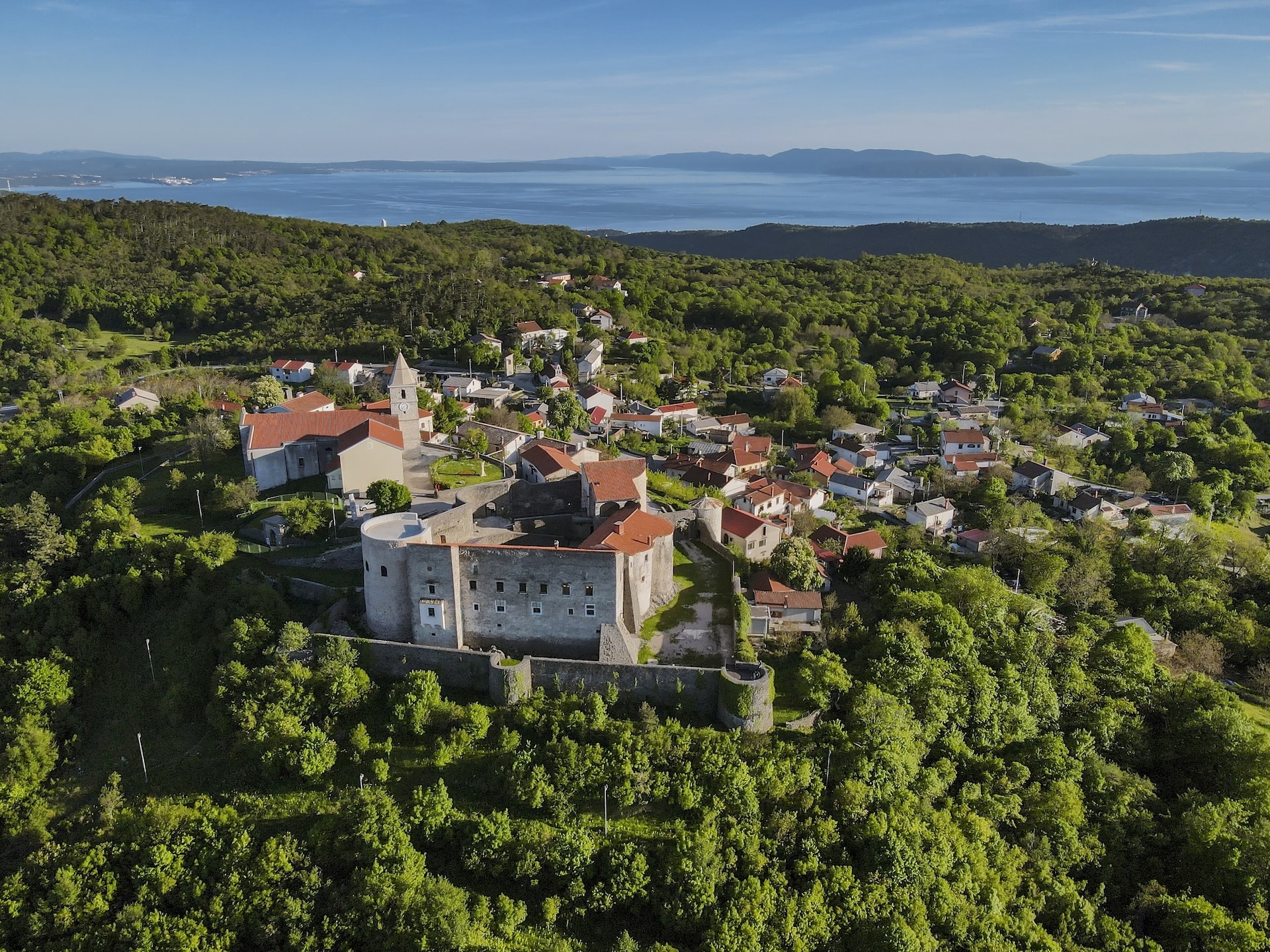
JELENJE
The Municipality of Jelenje is located in the central part of northern Croatian Littoral, within the Primorje-Gorski Kotar County.
Due to its unique topography, Jelenje is both a mountainous and coastal local government unit. The peak of Obruč, at 1,376 metres above sea level, is the highest summit of the mountain range known as the Grobnik Alps.
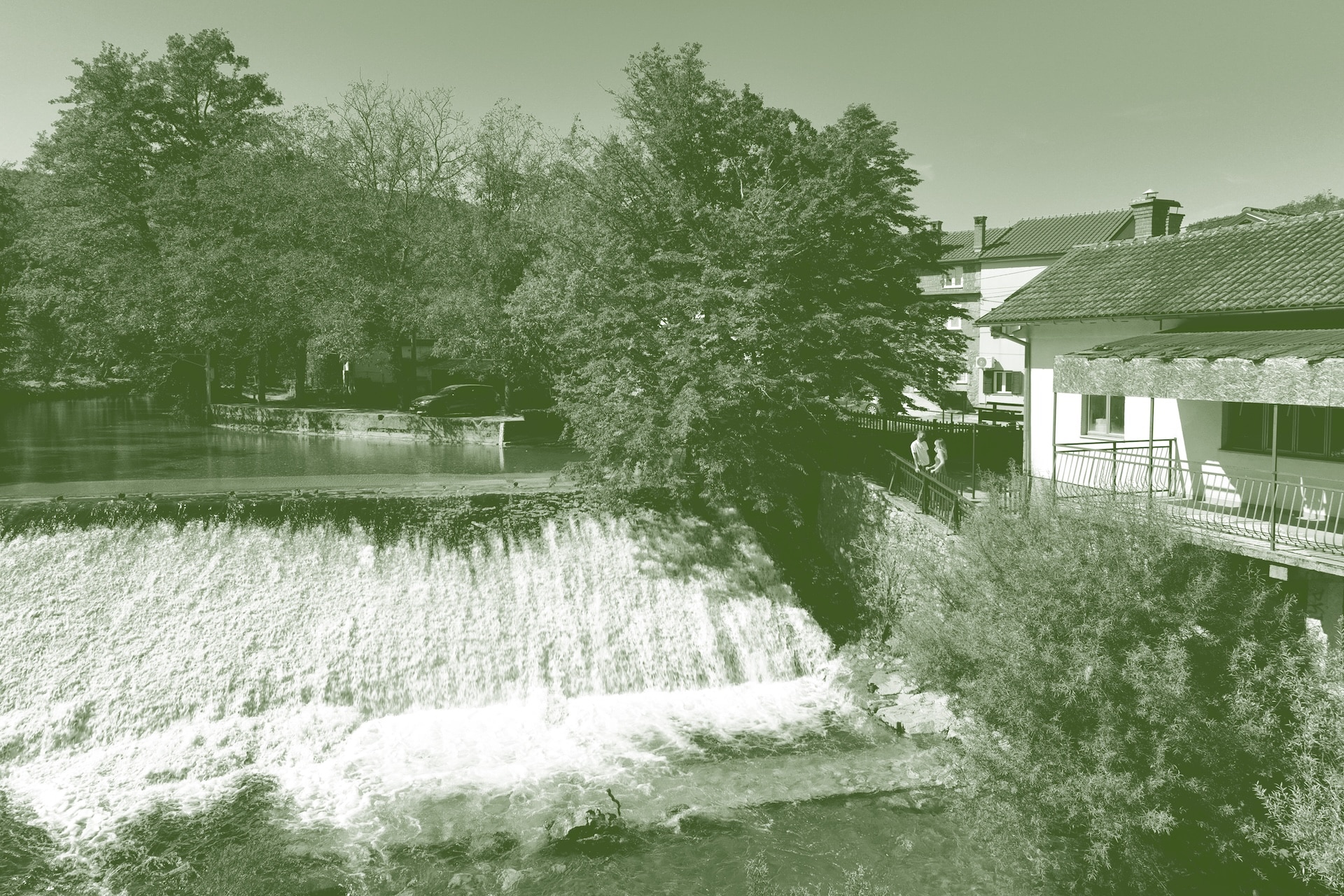
On the other hand, Jelenje is just about ten kilometres away from the nearest coastal point, where the river Rječina flows into the Adriatic Sea, near Rijeka, the administrative centre of the county. Climatically, the Municipality of Jelenje is among the rare local government units with what is described as a “continental-Mediterranean climate”. While this category is not officially recognised in climatology, it refers to an ideal mix of cool mountain air from the peaks of the Grobnik Alps and the sea breeze from the south. This makes Jelenje an ideal location for springtime vacations and outdoor recreation.
Rječina River originates beneath Kičelj Hill and is a true gem of Grobnišćina. Its canyon is legally protected, and the river runs for about 18 kilometres. It is accessible via a walking trail that lets visitors revel in its bubbling sounds and majestic atmosphere, enriched by the area’s flora and fauna. Rječina is bound to leave you speechless, but it’s not the only natural beauty that Jelenje has to offer.

Another recreational walking path, ideal for families with children, is the Sušica Trail, a circular route about two kilometres long. This easy and leisurely route follows the Sušica tributary of the Rječina, which flows only during heavy rains, likely giving it its name. The trail can be completed with a relaxed pace in 30 minutes. For recreational and professional athletes, it can be traversed by jogging or brisk walking. Strategically located, it connects Dražice, Podkilavac, and Jelenje.
Roughly midway along the path, there is a fitness park equipped with various exercise stations. The trail’s configuration and circular shape make it ideal for recreational running and maintaining fitness. It can also be navigated by bicycle, and a children’s playground with benches for rest is available.
Along the trail, you’ll find celestial labyrinths – nine stone sculptures symbolising connections with the planets. A special attraction is the great waterfall, which, during heavy rainfall, captivates with its strength and beauty. A water gauge nearby allows you to measure the flow of the waterfall.
The Grobnik Alps, previously mentioned, are a chain of monumental relief peaks bordering Grobnik Field, a historically significant site, particularly due to the legendary battle of the Croatian army against the Tatars in 1242. The Alps comprise a total of 16 marked and designated mountain peaks, the most famous and lowest of which is Hahlić (1,097 metres).
The beautiful western slopes of Gorski Kotar can be easily reached from Podkilavac, the northernmost settlement in the Municipality of Jelenje. At the summit of Hahlić lies a mountain lodge of the same name, one of the finest in Croatia. Dedicated mountaineers take care of it and are ready to welcome visitors. The ascent to Hahlić is truly special, offering stunning views of the entire Kvarner Bay through beautiful natural landscapes and open grassy slopes.
Slightly below the lodge, on a small plateau, are three small ponds, a favourite watering spot for various wildlife. The Hahlić area takes its name from these ponds, originally called “Kalići”, which evolved into “Hahlići” due to linguistic distortion.
Cyclists will be pleased to know that a cycling centre is currently under construction in Rastočine (Podkilavac), serving as the starting point for all cycling routes in Jelenje. These routes are actively used for training and youth education by the Grobnik Cycling Club.
There are countless ways to spend exciting leisure time and connect with nature in Jelenje. Your adventure can also begin on horseback, allowing you to explore Grobnik’s forests, mountains, and the Rječina River. These experiences are sure to leave you with long-lasting and beautiful memories. Horseback riding is available in Lukeži at the Vodičajna Equestrian Club and in Lopača at a large and well-equipped ranch designed for recreational and therapeutic riding. With expert guidance and reliable horses, even first-time riders will discover why horses have historically been humanity’s best companions.
Exploring hidden natural corners can also be an adrenaline-filled experience if you embark on a quad bike adventure. Guided by the Quad Experience team, this four-wheeled excursion offers an unforgettable adventure and memories to last a lifetime.
